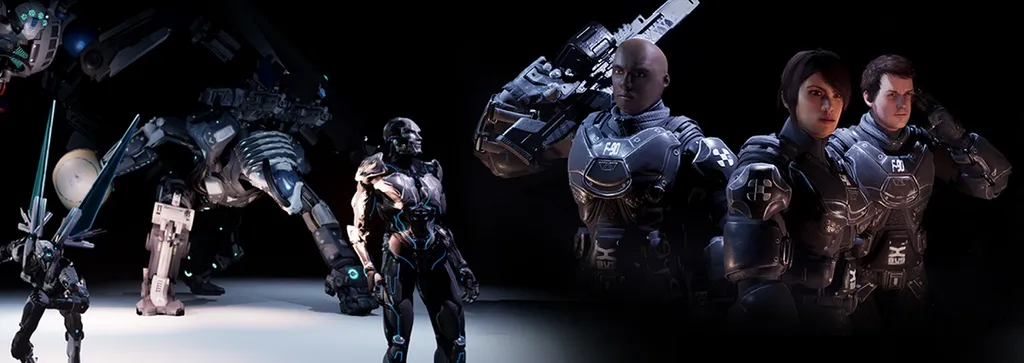We first saw Labrodex Studios’ first VR project — the futuristic shooter Scraper: First Strike — earlier this year when we had a chance to go hands-on with the game at their office on Long Island. It’s been a few months since our first playtest, and the game has not only gotten more polish, but it was announced recently that Scraper would be coming to PSVR as well as the full range of PC headsets.
To get a little more background on the story behind Scraper, be sure to read a few chapters of Ryder Windham’s lead-in novel — Scraper: The Rise of Cifer. You can get a digital copy of the book by registering at ScraperNetwork.com, as well as a free in-game weapon: the Debilitator.
Scraper: Rise of Cifer
We had a chance to catch up with the team at Labrodex and get an update from them on what they’ve been working on since the last time we saw the project.
UploadVR: How did you go about building Scraper from idea to a concept that spans multiple mediums?
Jim Ivon, CEO: First, thank you for the opportunity to talk about Scraper: First Strike in VR. We are incredibly excited about releasing Episode I later this year.
Years before starting Labrodex, I had begun writing down ideas for new IPs. I’m a big RPG shooter fan and knew that if ever had the chance, I would want to create something in that space. I’m also an avid believer in VR and once the technology started to become mainstream, I decided to start a studio and work on our first VR project. Labrodex was also a way for me to contribute to the gaming community by hiring a team of super stars and providing them with the best tools and resources I could.
At the time, there were already some very cool VR titles, just nothing in the bigger RPG category. I felt if we could deliver a new type of seated experience where you could explore large levels, have full locomotion, dynamic missions, engineering, scavenging and several other traditional RPG elements, we could have a big impact. From the beginning, the goal was to create a new IP, not just a VR game, with the ultimate objective of releasing the full game on PC and next gen consoles in 2020.
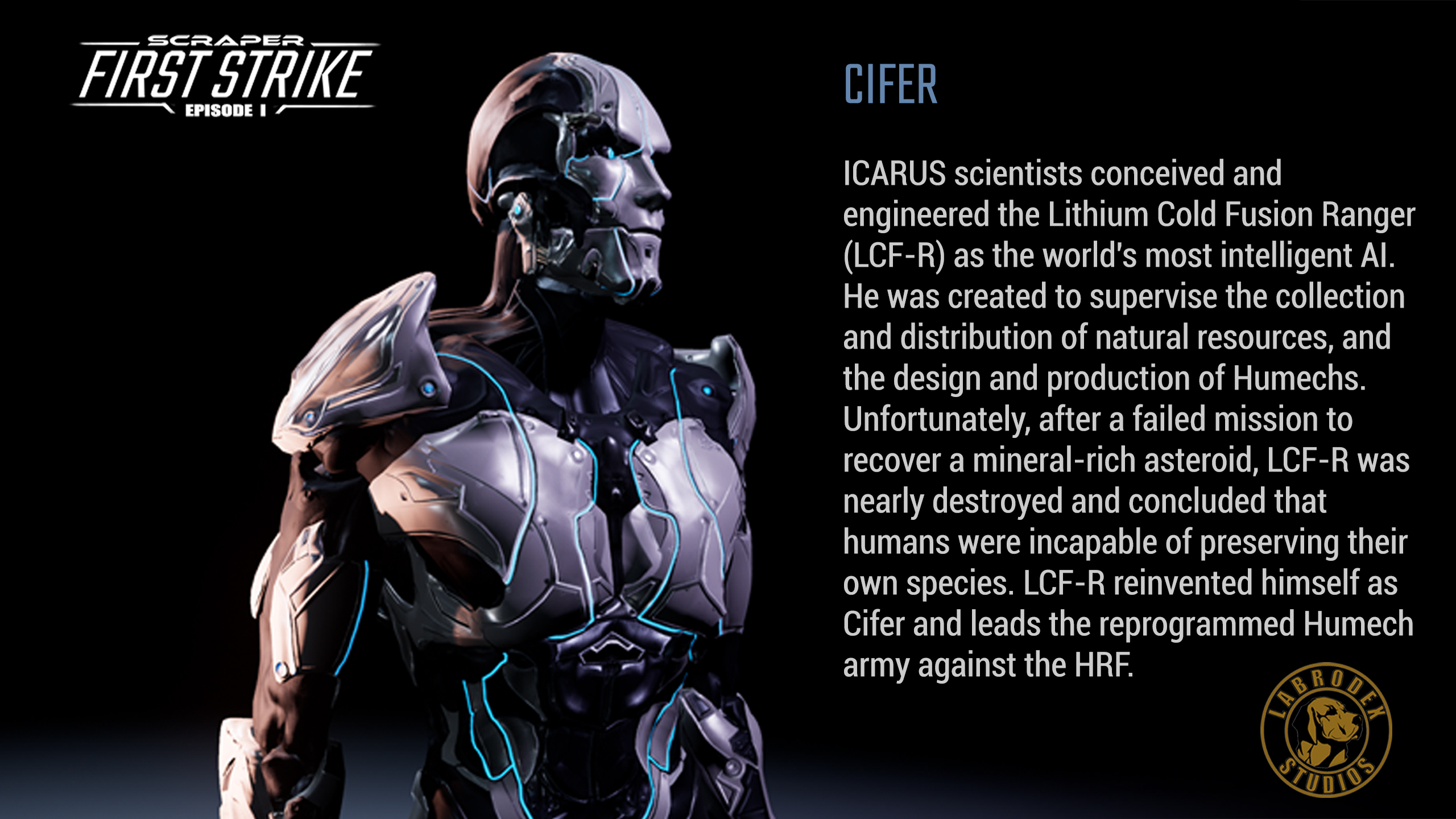
The plan was to launch the IP in phases. Phase one was the prequel novel to the game. We teamed up with the brilliant Ryder Windham, a well-known sci-fi author with more than 80 books under his belt to write the story. I gave Ryder all of my notes on Scraper and we talked daily for several weeks about the characters, environments, world, story arcs and finally the foundation for the novel. Ryder did an amazing job bringing the characters and world to life. The book, Scraper: The Rise of Cifer ends right where the game begins and can be found on Amazon. Reading the book before playing Episode I will give the player a fantastic foundation of the world and its main characters.
Phase two was to release Episode I, Scraper: First Strike on the major VR platforms. There are five episodes planned for the first game in the series. The initial story arc has a total of three games planned, or 15 total episodes.
Several leading IPs have ported to VR, but I thought we could do something different and launch a new IP with VR in the hopes of drawing enough attention to the Scraper universe to spawn additional games, books and beyond.
UploadVR: Where are you now with the game and what are you focusing on before release?
Ivon: We are feeling really good about Episode I. We see Scraper as a marathon, with Episode I being the first step. The team is working incredibly hard to start off on the right foot.
Episode I is meant to introduce the player to the world of Scraper, give them a taste of the numerous RPG features in the game (that will be expanded in future episodes) and to create an extremely fun and fulfilling experience. We think we are just about there.
We are heavy into the polishing and balancing phase. Everyone on the team is a gamer, with most being extremely involved in the gaming community, so their real-world experience has been invaluable to upping the fun factor and quality of the title. Everyone wants nothing more than to deliver a premium experience for players.
We are also working hard on the custom builds for the 4 different VR platforms. This is a massive challenge by itself. We are creating custom control schemes for each platform and have performance and tuning to do individually on each one.
There is a fantastic energy buzzing around the studio. We are self-funded and have limited resources with our smaller team size, but everyone in our tight-knit group excels at their position, which has given us tremendous results. I’m extremely proud of what this team has done in the past 1 1/2 years.
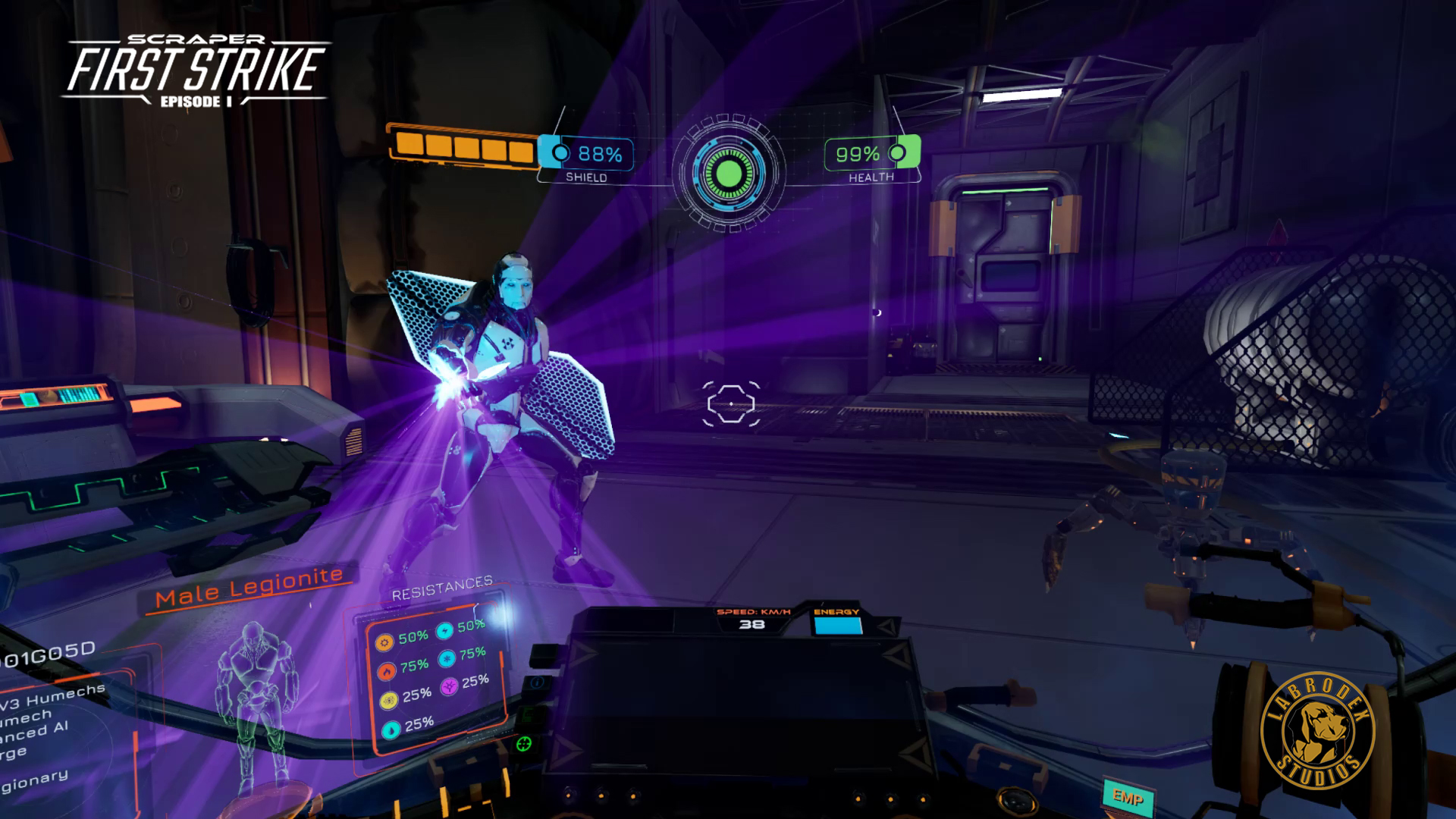
UploadVR: Why VR?
Ivon: There is no greater sense of immersion when experiencing something fictional than when you are in VR.
Scraper is a sci-fi shooter with fantastic structures, large machines, futuristic robots and dazzling weaponry. In addition, the player can travel around the world freely doing missions, engineering weapons, scavenging for parts, interacting with key characters and wiping out hordes of Humechs. When you combine this with the latest VR technology, you are transported to New Austin and become a part of the world.
Scraper was built from the ground up with VR as the focal point. This meant encounters, interactions, combat and just cruising around levels had to be tested and reworked multiple times to achieve a realistic sense of immersion. The feeling of controlling weapons with your arms, activating numerous offensive and defensive capabilities with your hand and finger gestures to successfully come out of a dangerous situation is an awesome feeling in Scraper.
When thinking of the ultimate way to launch the IP, VR was the obvious choice. As computing power improves, VR technology expands to include things like eye tracking and foveated rendering, the real question in the near future is going to be “why not VR?”
UploadVR: A lot of VR shooters use VR to a simple degree, only allowing the player to look around and point a gun. Scraper is being built from the ground-up with virtual reality in mind. How are you thinking about using the interactivity and immersiveness of virtual reality in Scraper?
Andrew Hurley, Senior Level Designer: When building and designing Scraper, we have done our best to keep in mind any player interactions that could be ported to VR. A simple example of this would be converting a button press to a gesture, like a salute or thumbs up. A more complex example would be shifting user interface elements to be completely 3D and exist in the virtual world, allowing the player to physically interact with buttons and icons to create a deeper and more immersive experience.
Another great way we keep players immersed is by allowing them to modify controls like rotation speed, movement speed, and interior light color of the player’s MHP (Modified Hover Pod). In a non-VR game these types of options usually require the player to go to some type of settings menu. Our implementation lends itself to a more fluid gameplay experience by keeping the controls within the players immediate grasp. This also helps create the believability that you are inside of a functioning vehicle with various switches and buttons to explore. These are just a couple examples of how we have kept VR interactivity in mind while designing the game

UploadVR: What makes Scraper unique and where do you think Scraper will really differentiate itself from so many other shooters?
Alex Sentell, Lead Animator: What makes Scraper unique to me is that it’s not a VR “experience” or something that feels like it’s using VR as a gimmick. Scraper plays more like a FPS, that is enhanced by virtual reality. To me that makes Scraper more accessible for inexperienced VR users without feeling like it’s watering down the game.
Additionally, one of my favorite memories during development was when we were showing off a demo at PAX East and a person in a wheelchair was able to have the full experience in VR. She said she didn’t get to play too many VR games but loved that there was something accessible to her too. I think the middle ground we hit between pushing VR without limiting gameplay helps us stand out from some other VR titles.
UploadVR: Are there any design concepts that you thought were a great idea at the time but didn’t play out that well in VR or that you had to change or tweak from your original vision?
Victor Matos, Project Manager: When revamping the MHP’s (Modified Hover Pod’s) functionality, we added a dashboard for increased interactivity. We soon realized that we had to make shooting downwards towards targets more feasible. One of the potential design solutions was to rotate the MHP to match the grade of the slope the player was traveling on. Simply speaking, if you went down a slope or ramp, the MHP would tilt itself forward so that aiming at enemies at a lower elevation would be easier to shoot. We had high hopes for this solution, but our innocuous tilt wasn’t very VR friendly despite answering our problem.
We decided to revert the change, however it incentivized us to start actively working towards VR comfortability settings, such as vignetting, snap rotation, rotation speed, and movement speed settings. These functions paired with maintaining a high frame rate created a comfortable full locomotion experience during gameplay. For those that prefer higher control of comfort settings, they’ll find numerous options available that they can adjust in Scraper.
Our survey data from PAX EAST 2018 suggested that players didn’t experience any more motion sickness than they would playing a standard non-full locomotion VR game, so we’re very hopeful that we’ve created an enjoyable experience where the player can travel around large levels using 360-degree full locomotion while maintaining a rich gameplay experience!
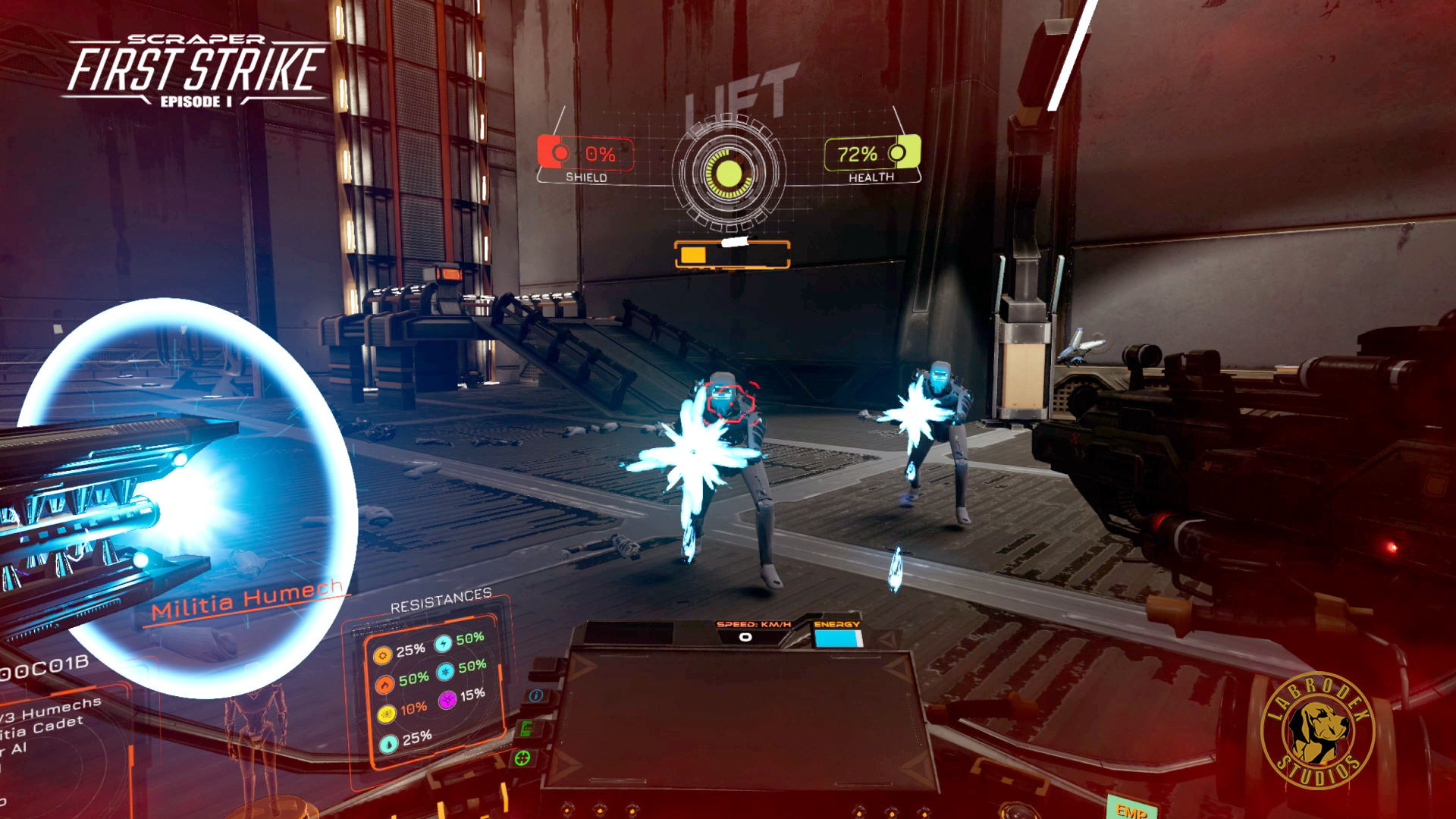
UploadVR: Are there any design choices that came up during development that completely surprised you in a good way?
Matos: During the early stages of development, aerial enemies would drop loot pieces at unreachable locations. This meant players would have to accept that they’d never get their hands on that two percent epic drop behind the non-traversable fence, so we looked for a solution!
We didn’t need to search very far to end up with our point pick up mechanic: point towards an item with your aiming lasers and it will magnetically pull the item toward the player and into your inventory. At the time, we thought we simply just answered a game design problem, but shortly afterwards the office was buzzing over how fun it was to have telekinetic powers. It was a seemingly simple solution that had a huge impact. Not only was it entertaining, but it spared players from having to walk over loot, which is great for VR, and allowed players to recover their lost loot in those hard to reach places.
Another design choice we experimented with was enabling slow motion when players are accessing their Weapon Wheel. Prior to this, players had to swap their weapons in the heat of battle by scrolling through them one at a time. Because we have 7 unique weapons in Episode I, this became difficult to do quickly
without being overwhelmed by enemy fire. Combat is fast paced and can be a challenge. By slowing time, the player can select the right weapon for the right situation while accounting for enemy resistances and analyzing enemy makeup. We’re still testing this feature, but we’re optimistic on its outlook as we quite enjoy watching enemy robot’s limbs and heads blow apart in slow motion. We think the player base will too.
UploadVR: You’re coming out on all the major VR platforms, from PSVR to all the PC-based headsets. Are you thinking about Quest yet?
Ivon: We’ve actually spoken with Oculus about Scraper on the Quest, along with other potential projects. I was lucky enough to be invited to the private demo months ago, and it was impressive. Wireless, lighter, self-contained power and computer tech is of course the future of VR. The Quest is the first venture towards that goal, and we are excited at the prospect of developing projects for that platform. Oculus has something special with the Quest.
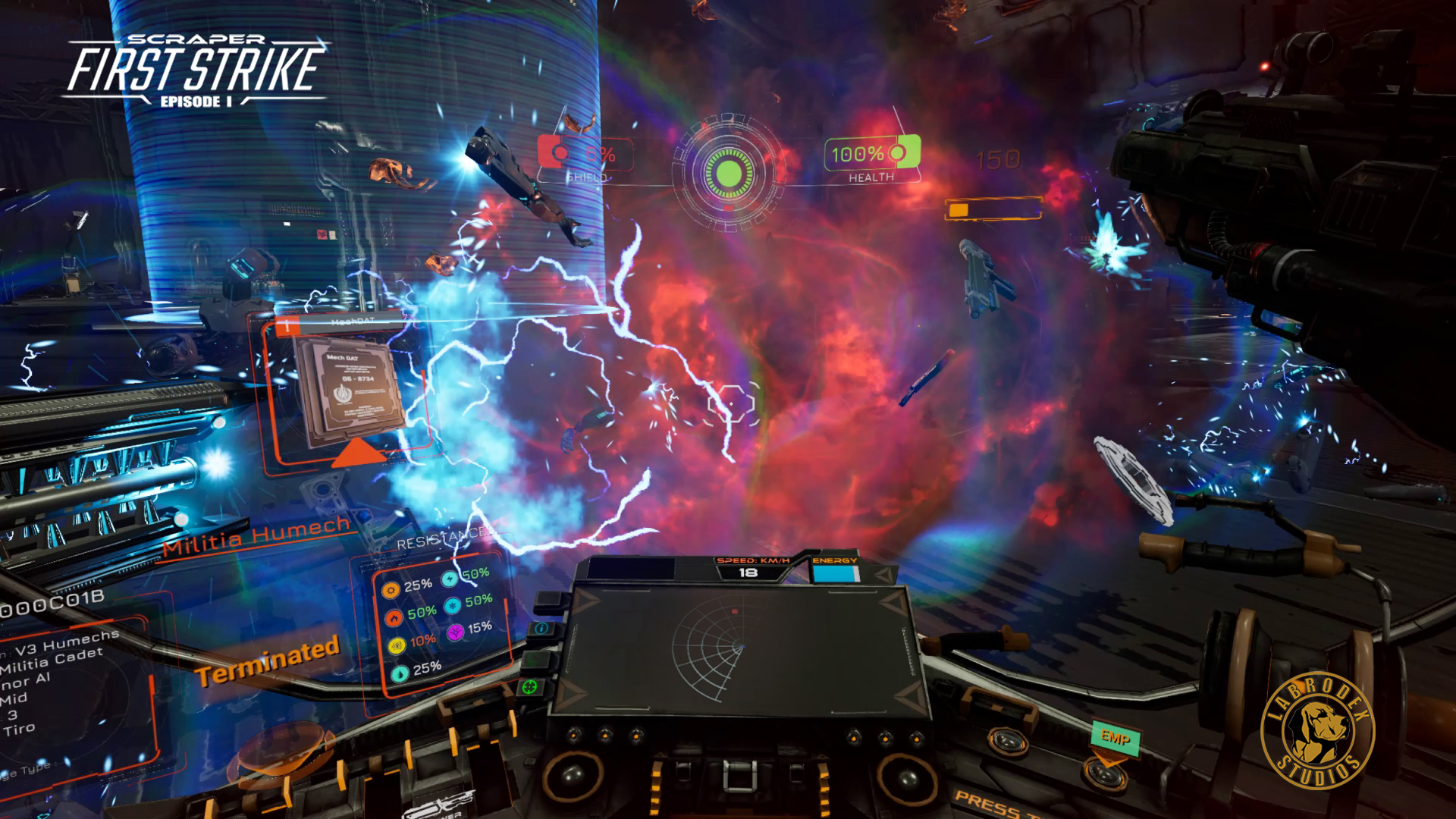
UploadVR: The plan with Scraper is to release a smaller slice in 2018 with a full-scale game in 2020. What else does Labrodex have in the works?
Ivon: We are releasing Episode I in late 2018, with Episode II planned for early 2019 release. We’ve already started on Episode II and have some great things planned for new features and immersion. I can share something that has not been released yet, and that is Episode II will be called, Scraper: Sudden Death.
Back in January when UploadVR released the first article on the game, we were contacted by a few of the top publishers to find out what the game and studio were about. Since then, we’ve been talking with them periodically to discuss progress, the IP and long-term goals. Those talks have been extremely fun.
Labrodex Studios is a Creative Services firm and we have three distinct divisions. The Original Content division is for our internal IPs like Scraper, The Enterprise Division is for corporate clients looking for AR/VR and traditional 3D solutions and our 3rd Party Division will work on outside projects from other entertainment firms.
We have a couple of other IPs that can be developed, but finishing Episode I while working on Episode II is priority at the moment. We have also been contacted by a few corporate brand managers about AR and VR solutions for their products and services. We’ve begun exploring those projects and are eager to start on them.

